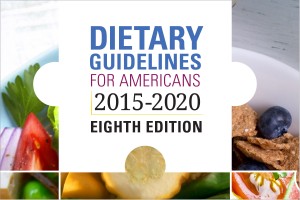Mar
11

Posted by Carolyn Martin on March 11th, 2016
Posted in: Health Literacy, Public Health
 Already lagging on your New Year’s resolutions? Well, spring is a time for renewal and a fresh start! March is a great time to take a look at the recently released U.S. Dietary Guidelines and renew your resolve to eat healthier. What are the U.S. Dietary Guidelines? Published every five years for the general public as well as public health professionals, and policy makers, the Dietary Guidelines for Americans provides food recommendations for people aged two years and older. Each edition reflects the current nutritional science, with a focus on chronic disease prevention.
Already lagging on your New Year’s resolutions? Well, spring is a time for renewal and a fresh start! March is a great time to take a look at the recently released U.S. Dietary Guidelines and renew your resolve to eat healthier. What are the U.S. Dietary Guidelines? Published every five years for the general public as well as public health professionals, and policy makers, the Dietary Guidelines for Americans provides food recommendations for people aged two years and older. Each edition reflects the current nutritional science, with a focus on chronic disease prevention.
What are some of the changes from the last edition? Previous editions had focused on specific dietary components such as food groups or nutrients. The current edition instead, emphasizes overall eating patterns, the combinations of all the foods and drinks that people consume every day. Included in the current edition are updated guidance on topics like added sugars, sodium, and cholesterol and new information on caffeine. This is the first edition to recommend a limit to consume less than 10 percent of calories from added sugars in order to control overall calorie intake. On a 2,000-calorie daily diet, that’s about 12 teaspoons while most Americans typically ingest closer to 22 teaspoons a day.
Thankfully the Office of Disease Prevention and Health Promotion done a very basic breaking down of the current focus of the new guidelines for us to follow without being too specific because as the executive summary says, “These Guidelines also embody the idea that a healthy eating pattern is not a rigid prescription, but rather, an adaptable framework in which individuals can enjoy foods that meet their personal, cultural, and traditional preferences and fit within their budget.”
The government has helpfully provided the “Top 10 Things You Need to Know About the 2015-2020 Dietary Guidelines for Americans“. And of course, MedlinePlus has some additional nutrition information that you can always use.